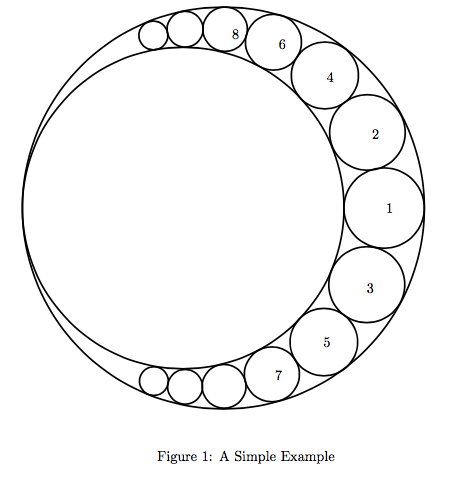HDU 6158 笛卡爾定理+韋達定理
阿新 • • 發佈:2017-08-21
careful esp efi wiki ide sea element itl cas

At first, haha‘s teacher gives him two big circles, which are tangent with each other. And, then, he wants to add more small circles in the area where is outside of the small circle, but on the other hand, inside the bigger one (you may understand this easily if you look carefully at the Figure1.
Each small circles are added by the following principles.
* every time you add a small circle, you should make sure that it is tangented with the other circles (2 or 3 circles) like Figure1.
The teacher wants to know the total amount of pigment he would use when he creates his master piece.haha
Task
The teacher would give you the number of small circles he want to add in the figure. You are supposed to write a program to calculate the total area of all the small circles.
Contains a number in a single line, which shows the total area of the small circles. You should out put your answer with exactly 5 digits after the decimal point (NO SPJ).
The Designer
Time Limit: 8000/4000 MS (Java/Others) Memory Limit: 32768/32768 K (Java/Others)
Total Submission(s): 761 Accepted Submission(s): 142

At first, haha‘s teacher gives him two big circles, which are tangent with each other. And, then, he wants to add more small circles in the area where is outside of the small circle, but on the other hand, inside the bigger one (you may understand this easily if you look carefully at the Figure1.
Each small circles are added by the following principles.
* every time you add a small circle, you should make sure that it is tangented with the other circles (2 or 3 circles) like Figure1.
The teacher wants to know the total amount of pigment he would use when he creates his master piece.haha
Task
The teacher would give you the number of small circles he want to add in the figure. You are supposed to write a program to calculate the total area of all the small circles.
Input The first line contains a integer t(1≤t≤1200), which means the number of the test cases. For each test case, the first line insist of two integers R1 and R2 separated by a space (1≤R≤100), which are the radius of the two big circles. You could assume that the two circles are internally tangented. The second line have a simple integer N (1≤N≤10 000 000), which is the number of small circles the teacher want to add.
Output For each test case:
Contains a number in a single line, which shows the total area of the small circles. You should out put your answer with exactly 5 digits after the decimal point (NO SPJ).
Sample Input 2 5 4 1 4 5 1
Sample Output 3.14159 3.14159
Source 2017中國大學生程序設計競賽 - 網絡選拔賽 笛卡爾定理 參考分析
1 #include<iostream> 2 #include<cstdio> 3 #include<cmath> 4 #include<cstring> 5 #include<algorithm> 6 #include<set> 7 #include<map> 8 #include<queue> 9 #include<stack> 10 #include<vector> 11 using namespace std; 12 #define mod 1000000007 13 typedef long long ll; 14 int t; 15 int r1,r2,n; 16 int main() 17 { 18 scanf("%d",&t); 19 while(t--) 20 { 21 scanf("%d %d %d",&r1,&r2,&n); 22 if(r1<r2) swap(r1,r2); 23 double k1,k2,k3,k4,ans; 24 k1=-1.0/r1; 25 k2=1.0/r2; 26 k3=1.0/(r1-r2); 27 k4=k1+k2+k3; 28 ans=(r1-r2)*(r1-r2); 29 n--; 30 for(int i=1; i<=n; i+=2) 31 { 32 double r4=1.0/k4; 33 if(r4*r4<1e-13) 34 break; 35 ans+=r4*r4; 36 if(i+1<=n) ans+=r4*r4; 37 double k5=2*(k1+k2+k4)-k3; 38 k3=k4; 39 k4=k5; 40 } 41 printf("%.5f\n",ans*acos(-1.0)); 42 } 43 return 0; 44 }
HDU 6158 笛卡爾定理+韋達定理
